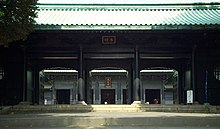| Hayashi Hōkō | |
|---|---|
 Hayashi Hōkō, 1st rector of Yushima Seidō Hayashi Hōkō, 1st rector of Yushima Seidō | |
| Born | 1644 Edo |
| Died | 1732 Edo |
| Occupation | Neo-Confucian scholar, academic, administrator, writer |
| Subject | Japanese history, literature |
| Children | Hayashi Ryūkō, son |
| Relatives | Hayashi Gahō, father Hayashi Razan, grandfather |
Hayashi Hōkō (林 鳳岡, January 11, 1644 – July 22, 1732), also known as Hayashi Nobutatsu, was a Japanese Neo-Confucian scholar, teacher and administrator in the system of higher education maintained by the Tokugawa bakufu during the Edo period. He was a member of the Hayashi clan of Confucian scholars.
Hōkō was the tutor of Tokugawa Tsuneyoshi.
Following in the footsteps of his father, Hayashi Gahō, and his grandfather, Hayashi Razan, Hōkō would be the arbiter of official neo-Confucian doctrine of the Tokugawa shogunate. As a result of his urging, the shōgun invested Confucian scholars as samurai.
Academician
Hōkō was the third Hayashi clan Daigaku-no-kami of the Edo period. After 1691, Hōkō is known as the first official rector of the Shōhei-kō (afterwards known as the Yushima Seidō) which was built on land provided by the shōgun. This institution stood at the apex of the country-wide educational and training system which was created and maintained by the Tokugawa shogunate. Gahō's hereditary title was Daigaku-no-kami, which, in the context of the Tokugawa shogunate hierarchy, effectively translates as "head of the state university".
The scholars of the Hayashi school were taught to apply what they had learned from a Confucian curriculum. Typically, they applied the Confucian texts conservatively, relying on Soong Confucian anlayis and metaphysical teachings.
The neo-Confucianist scholar Arai Hakuseki generally expressed scant regard for opinions expressed by Hayashi Hōkō.
Selected works
This is a dynamic list and may never be able to satisfy particular standards for completeness. You can help by adding missing items with reliable sources.- Kai hentai (Chinese Metamorphosis), reports of Chinese junks arriving in Nagasaki, 1640–1740.
See also
Notes
- ^ Nussbaum, Louis Frédéric et al. (2005). Japan Encyclopedia, p. 300.
- De Bary, William et al. (2005). Sources of Japanese Tradition, Vol. 2, p. 443.
- ^ Arakai, James et al. (2008). Early Modern Japanese Literature: an Anthology, 1600-1900, p. 378 n12.
- Tarling, Nicholas. (1998). The Cambridge History of Southeast Asia, Vol. 1, p. 161.
References

- Arakai, James T. and Haruo Shirane. (2008). Early Modern Japanese Literature: an Anthology, 1600–1900 (abridged). New York: Columbia University Press. ISBN 978-0-231-10990-1/ISBN 978-0-231-10991-8/ISBN 978-0-231-14414-8/ISBN 978-0-231-144155; OCLC 255022419
- De Bary, William Theodore, Carol Gluck, Arthur E. Tiedemann. (2005). Sources of Japanese Tradition, Vol. 2. New York: Columbia University Press. ISBN 9780231129848; OCLC 255020415
- Nussbaum, Louis Frédéric and Käthe Roth. (2005). Japan Encyclopedia. Cambridge: Harvard University Press. ISBN 978-0-674-01753-5; OCLC 48943301
- Tarling, Nicholas. (1998). The Cambridge History of Southeast Asia. Vol. 1. Cambridge: Cambridge University Press. ISBN 978-0-521-77864-0; ISBN 978-0-521-66369-4; ISBN 978-0-521-66370-0; ISBN 978-0-521-66371-7; ISBN 9780521663724; OCLC 43674066
External links
| Preceded byHayashi Gahō | 1st rector of Yushima Seidō 1691–1732 |
Succeeded byHayashi Ryūkō |